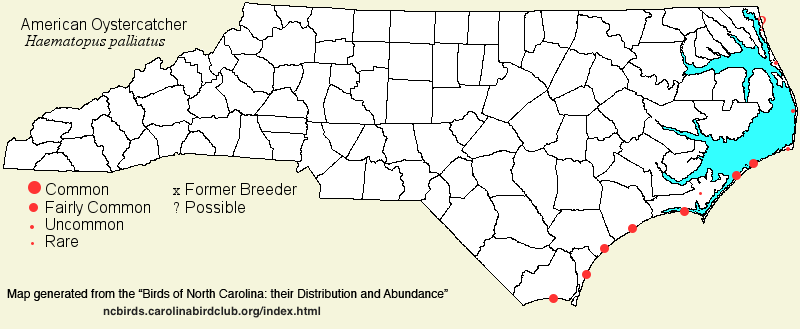 |  |
|
American Oystercatcher - Haematopus palliatus Sole representative of HAEMATOPODIDAE in NC | Search Common: Search Scientific: |
|
|
|||||||
| General Comments | The American Oystercatcher is one of the more spectacular shorebirds and is one of the few that remains in the state to breed. Unlike most shorebirds, it is strictly coastal, straying inland only after storms, even though it is somewhat migratory. Oystercatchers not only nest on open sand flats in the general neighborhood with Piping and Wilson's plovers and various terns, but they also breed in more sheltered sandy spots within tidal marshes; a few are now nesting on gravel rooftops. As with nearly all birds that nest on the ground on coastal sand flats, nesting populations are declining in the face of increased human visitation to beaches and increased numbers of mammalian predators. Unlike its nesting associates, it does not feed along sandy shores or sand flats, but forages mainly where there are oysters, such as on exposed sand bars and mudflats during low tides. It also forages on rocks, such as at jetties and bridge pilings. | ||||||
| Breeding Status | Breeder | ||||||
| NC BRC List | Definitive | ||||||
| State Status | SC | ||||||
| U.S. Status | |||||||
| State Rank | S3B,S3N | ||||||
| Global Rank | G5 | ||||||
| Coastal Plain | Breeding permanent resident along the coast, with migratory movements; slightly declining. Generally fairly common along the entire coast during the breeding season and migration periods, somewhat more numerous along the southern coast; numbers depart the northern coast in fall, such that it is uncommon in winter on the Outer Banks (and may be rare in the middle of winter), but still fairly common along the southern half of the coast. It can be locally common in a few southern coastal areas in migration and winter. Apparently the only Tidewater record is one at a dock at the Pamlico Plantation Marina (Beaufort) on 31 Mar 2022 [Chat 86:77 link]. Accidental farther inland in migration: one, Tar River near Greenville, 16 May 1990 [Chat 55:37 link], and one at Buckhorn Reservoir (Wilson), 15 Sep 2018 [Chat 83:25 link]. Peak counts: 300, Baldhead Island, 27 Sep 1986; 136, Fort Fisher, 29 Nov 1974. Breeding population: 2004: 250 pairs, 2007: ? pairs (NC Wildlife Resources Commission data). | ||||||
| Piedmont | Casual stray/vagrant, with only three records; 2, Roanoke Rapids Lake, 25 May 1998 [Chat 62:192 link]; 1, Jordan Lake, 15 Apr 2000 [Chat 64:154 link]; and 1, Falls Lake, 18 Sep 2011 [Chat 76:24 link]. None of these records likely were associated with major storms. | ||||||
| Mountains | No records. | ||||||
| Finding Tips |
This species is fairly easily found on barrier islands, such as at inlets, tidal flats, and especially at oyster beds. In winter, the species is quite common in the Fort Fisher area, with at least a couple of hundred birds overwintering. *** to **** | ||||||
| Attribution | LeGrand[2025-04-21], LeGrand[2023-03-10], LeGrand[2022-09-12] | ||||||
| NC Map Map depicts all counties with a report (transient or resident) for the species. | Click on county for list of all known species. |
| NC Breeding Season Map Map depicts assumed breeding season abundance for the species. |  |